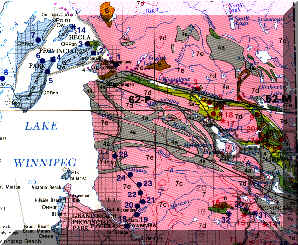Mining in Manitoba
Geology of the Bissett Area
GEOLOGY
.
 |
The Bissett Area consists of the Rice Lake group of sedimentary, volcanic, and derived metamorphic rocks, forming a continous belt. The volcanic rocks (basalt, andesite, dacite, rhyolite, and associated greywacke slate) are conformably overlain by a series of impure quartzite, greywacke, slate, and conglomerate. In the south part of the area these sediments have been altered to quartz-feldspar-mica schists. |
The Rice Lake group has been invaded by a series of calcic intrusions consisting of diabase dykes and sills, irregular sill-like bodies of gabbro, batholithic bodies of quartz diorite, and sills, dykes, and stocks of quart-feldspar porphyry. The calcic rocks are largely massive and are confined mainly to areas underlain by the rocks of the Rice Lake group.
Sediments of the San Antonio formation, conglomerate and felspathic quartzite unconformably overlie the Rice Lake group and one body of quartz diorite. The rocks at the unconformable contact are heavily sheared and apparently faulted.
The Rice Lake group has been folded into anticlinal structures. The limbs of these folds are steeply dipping. The San Antonio formation has been thrust over the Rice Lake rocks from the north and crumbled into a syncline and complementary anticline, the common limb of which is overturned. The folding of the San Antonio rocks appears to have accompanied invasion of the potash-bearing plutonic intrusions.
A number of longitudinal faults trending eastward are present in the Rice Lake volcanic and sedimentary rocks. Numerous smaller shear and fracture zones trending NW and NE cut the Rice Lake rocks and calcic intrusions. Many of the shears and fractures are occupied by gold-bearing quartz veins. These shear and fracture zones are most common in massive brittle rocks such as diabase, gabbro, and unbedded non-pyroclastic and pyroclastic rocks.
GOLD DEPOSITS
Many quartz veins in this area are mineralized with pyrite and minor chalcopyrite, sphalerite, and galena. Veinlets and patches of ankerite are present in most veins. The pyrite is in the form of small cubic crystals or as fine granular material in seams. Native gold is closely associated with the fine granular pyrite seams.
The gold-bearing quartz veins in the San Antonio mine occur in the thickest part of the north-dipping diabase sill that has intruded tuffaceous rocks of the Rice Lake group. The wall rocks are pyritized chlorite schists and are intensely albitized and carbonatized. Besides wall-rock alteration, the veins are characterized by haloes of country rock alteration that may extend 200 feet or more on both sides of the veins.